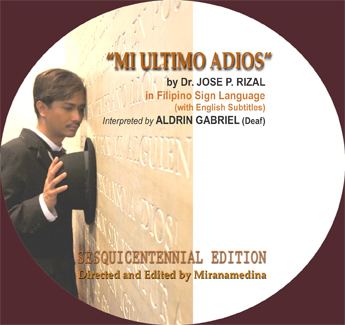Media type Print | Publication date 1879 Originally published 1879 Genre Poetry | |
 | ||
Similar Works by José Rizal, Other books | ||
A la juventud filipina to the filipino youth
A la juventud filipina is a poem written in Spanish by Filipino writer and national hero José Rizal, first presented in 1879 in Manila, while he was studying at the University of Santo Tomas.
Contents
- A la juventud filipina to the filipino youth
- a la juventud filipina akda ni dr jose rizal
- Summary
- Influences
- Awards
- Adaptations
- References
"A la juventud filipina" was written by Rizal when he was only eighteen years old, and was dedicated to the Filipino Youth.
a la juventud filipina akda ni dr jose rizal
Summary
In the poem Rizal praises the benefits that Spain had bestowed upon the Philippines. Rizal had frequently depicted the renowned Spanish explorers, generals and kings in the most patriotic manner. He had pictured Education (brought to the Philippines by Spain) as "the breath of life instilling charming virtue". He had written of one of his Spanish teachers as having brought "the light of the eternal splendor".
In this poem, however, it is the Filipino Youth who are the protagonists, whose "prodigious genius" making use of that education to build the future, was the "Bella esperanza de la Patria Mia!" (beautiful hope of the motherland). Spain, with "Pious and wise hand" offered a "crown's resplendent band, offers to the sons of this Indian land."
Influences
Some literary terms characteristic of the works of José de Espronceda can be observed throughout the poem, such as “tersa frente” or "amante anhelo" that appeared originally in the "Canto II a Teresa" of Espronceda.
Awards
The poem was presented in 1879 in Manila at a literary contest held in the Manila Lyceum of Art and Literature, a society of literary men and artists, where he won the first prize, composed of a feather-shaped silver pen and a diploma.
The poem has been translated to Tagalog by several auizal’s “Mi Ultimo Adios” is the most popular and most often recited version) translated the poem, but the translation contained flaws, as can be seen for example in the fifth line, where he translates "Bella esperanza de la Patria Mia!" as “Fair hope of my fatherland!” Alfredo S. Veloso made a translation of the poem into English. Philippine National Artist Nick Joaquin also translated the poem.
Adaptations
Oscar Yatco conducted a musical adaptation of the work in 1935 with Ramon Tapales' Mindanao Orchids.
